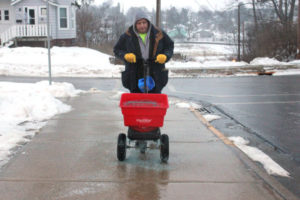
If a sidewalk is salted, ice may absorb the salt, which lowers its freezing point and may lead to melting. (Photo credit: Baraboo News Republic archives)
All objects exchange energy with their environment. They do this via conduction, advection, convection and radiation. If water is involved, a change in the water phase (liquid, solid or gas) also will involve an exchange of energy.
Conduction moves energy by physical contact. Convection results from hot air rising. Advection by the wind moves heat horizontally.
Radiative processes transfer heat throughout the entire atmosphere and into space. Radiation can be absorbed, reflected or transmitted. Convection and latent heating transfer heat over great distances through vertical motions and phase changes of water.
In the case of ice on a sidewalk, assuming the sidewalk has not been salted and there is no wind, the important energy exchange mechanisms are conduction and radiation. The ice is exchanging energy with both the sidewalk and the air around it via conduction.
If the atmosphere is below freezing, this will not result in the ice melting. If it is night time, and the sidewalk is below freezing, then this will not result in the ice melting. But during the day, the story could be different.
If the sun is shining on the ice, some of that solar energy will be absorbed. Ice is clear at visible wavelengths, the energy to which our eyes are sensitive. But the sun emits radiation at other wavelengths which water will absorb, and thus increases its energy gain.
If these gains exceed the energy losses, the ice will warm. If it reaches the melting point, the ice will start to melt. The sun can also add energy and warm the sidewalk, increasing its temperature to above freezing. This will then warm the ice via conduction and lead to its melting.
If the sidewalk has been salted, the ice may absorb the salt, which lowers its freezing point and may lead to melting.

